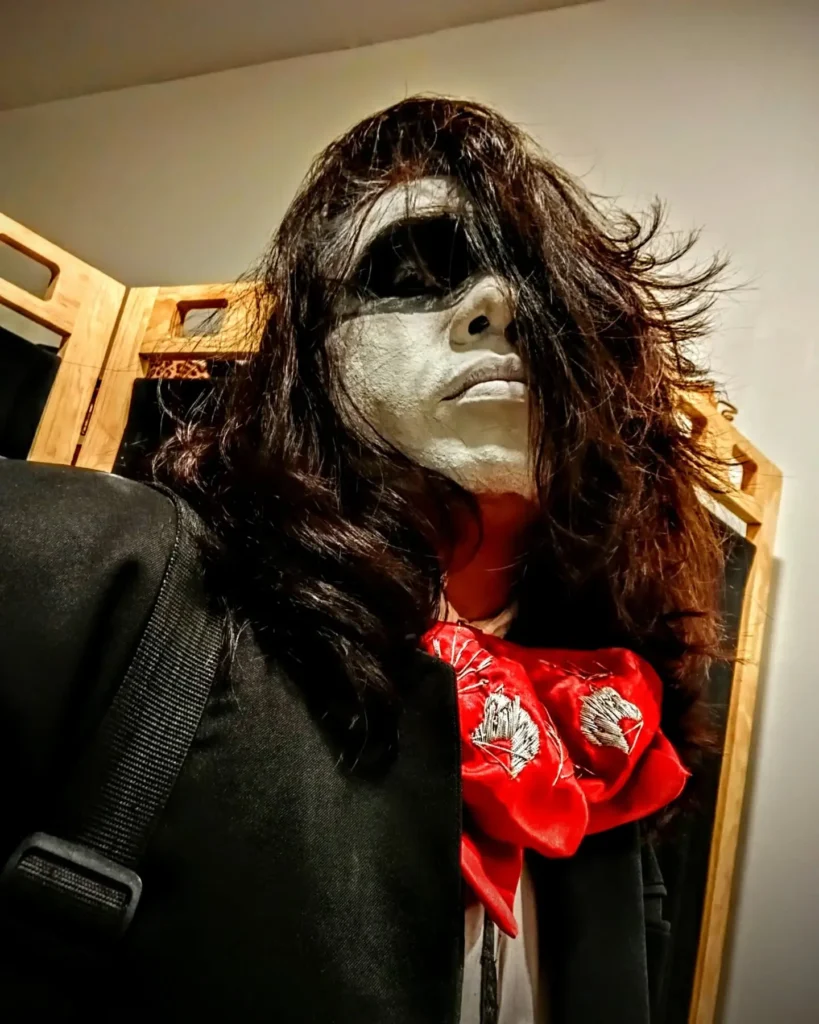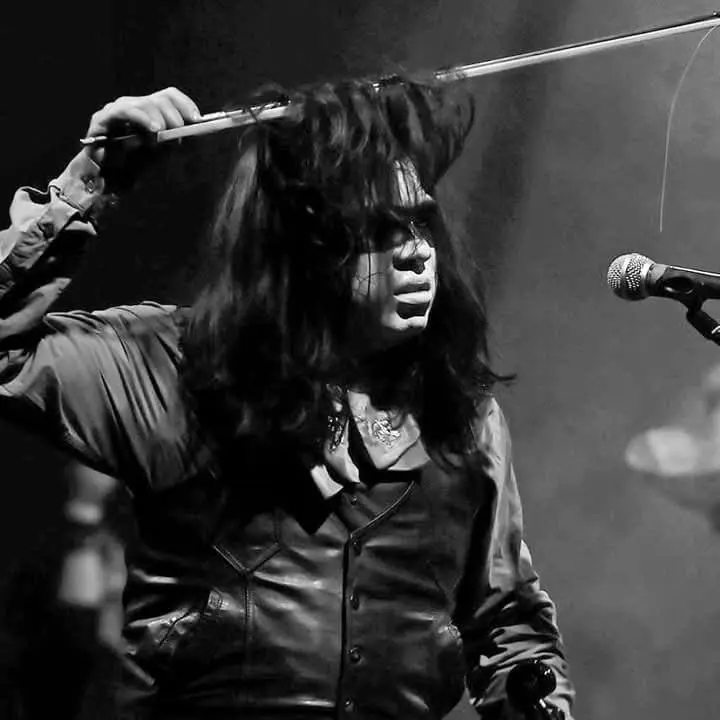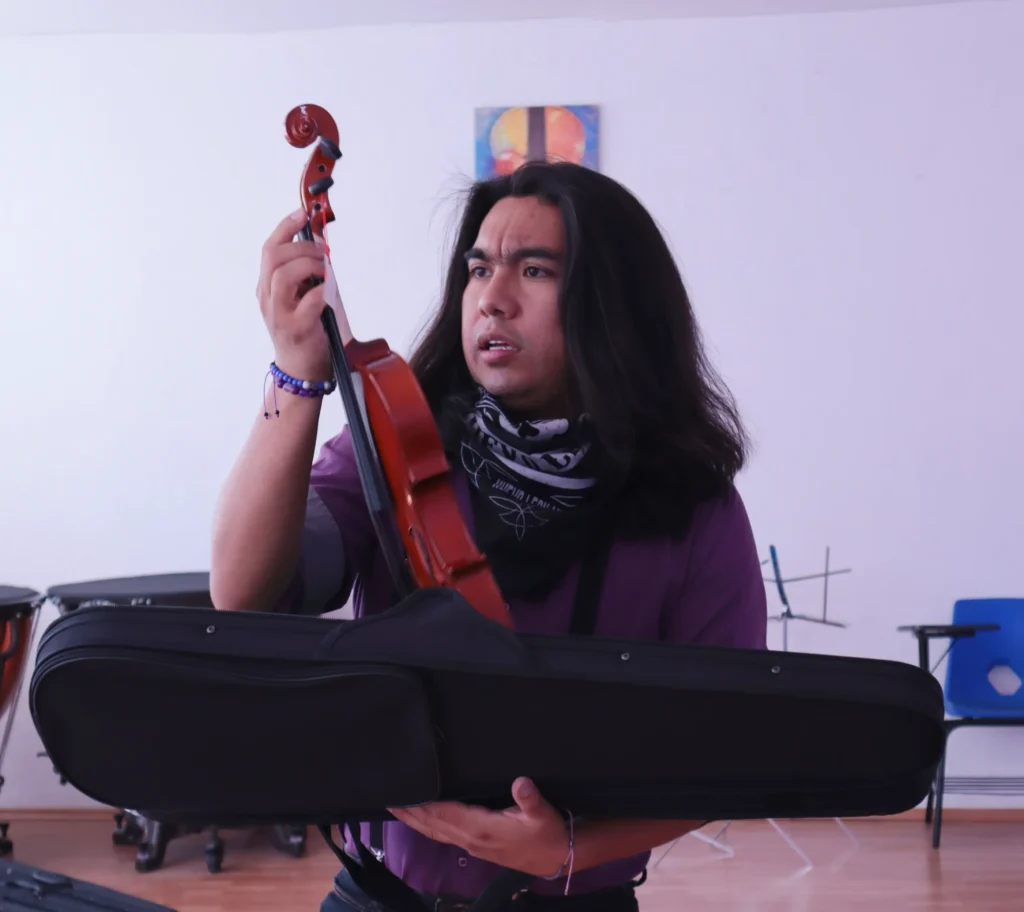Abraham Hernández, known as “Bram” when he performs with the band La Bande-son Imaginaire, is a 32-year-old musician of Mexican origin who has traveled the world, capturing the imaginations of thousands with a Mexican “darkwave” that blends indigenous heritage with a dark synthesizer.

But Abraham is more than his alter ego, Bram. When the spotlight goes down and the speakers fall silent, the musician never rests. He teaches in a government program called Schools for Life, where young people of all social classes and backgrounds have the opportunity to explore art.
Abraham Hernández, native of a place called Tláhuac in Mexico City, began his musical career in a free government program. He acknowledged in an interview with MxPA that a young man like him would not have been able to access the arts otherwise, and teaching at the School for Life, part of a Mexican government program, allowed him to close a loop and return to his community some of which he received when he was eight years old and began playing the violin.
Learning with Gratitude
Abraham Hernandez began taking classes in a social program called “Orquestas y Coros” in Mexico City 24 years ago under the tutelage of maestro Francisco Aquino Dominguez, a Peruvian who would eventually give Abraham his first violin.
“Walking with my mom, we heard instruments, and I said, ‘Hey, Mom, something sounds like violins. Let’s go check it out.'” That’s how Abraham found the community center that, under the current administration, is known as Pilares para el Bienestar, located in the La Nopalera neighborhood.
The Mexican musician recalls the incredible opportunity to be loaned an instrument through this Mexican government program, because in those years (and to this day), two or three thousand pesos was too much money for a family from a working-class neighborhood. This was coupled with the fact that during that time, Abraham’s family paid around eighty pesos a month for Maestro Francisco’s classes.
“You were basically paying for someone to clean, because you weren’t paying for the classes,” he commented about the minimal cost of receiving music education at this community center.
Surrounded by people driven to serve and help their community, Abraham began his musical career. Not only did Maestro Francisco guide the young musician, but more advanced colleagues also took it upon themselves to help him learn his instrument: “You begin to see a whole, super-beautiful community… these programs help you understand that the community, the social fabric, is very important, that you are not alone.”
Abraham quickly developed into a talented violinist, becoming the first violinist in the Tláhuac symphony orchestra, and realized it was time to pursue formal studies at the Ollin Yoliztli school.
The Tláhuac violinist then faced a very different reality after being accepted into the prestigious school at age 15. He saw classmates who came from formal education, who played much better than him, and who came from family circles that supported their musical career from the beginning: “It’s not that I was a bad violinist, it’s just that my background was different.”
Abraham came from community-based education, where everyone supported each other, and the priority was for students to learn. At this new school, students were in direct competition, and the pedigree of your musical career marked your status.
“You feel discriminated against,” the musician shared, recalling that he was judged for his origins in a family with no musical tradition and for coming from a social program. “I began to realize that this environment is very classist and very elitist.”
Before finishing his first year, the young musician realized that this type of education was slowly killing his love for art.
“What am I doing here? I don’t want to hate music; I love music, and this is making me hate it.” This was the thought that led Abraham to finally break with traditional music education. Later, he would try to resume his studies, but ultimately decided that this path was not for him.
The Rockstar Path
Disenchanted with chamber music and the world of so-called high culture, Abraham began to explore alternative genres and violinists who combined rock, jazz, and blues to make music outside the narrow canons of orchestras. It was on this journey of musical discovery that he met La Bande-son Imaginaire.

Originally from Oaxaca, brothers Oscar Tanat and Heri Angelo Tanat founded a darkwave band that calls to the dark souls with an unmistakably Mexican style. Abraham fell in love with their music and in a twist of fate, the Tanat brothers were looking for a violinist and were holding auditions.
After a phone interview, the Tanat brothers wanted to try out the orchestral violinist and see how he performed on stage. Shortly after, they agreed on the date for his debut at La Bande-son Imaginaire.
“That day, right before the show, my character emerged.” Abraham, who came from a classical music background, commented that he didn’t have a stage name or any particular attire other than the formal suits he wore while playing the violin.
The leather vest, coat, dance shoes, and mariachi bow tie completed a new musician, Bram.
“I remember the guys, the Tanat brothers, turning to look at me (and saying), ‘Are you ready? Get ready because this is going to be crazy.’”
Baptized as Bram, he recalled the deafening screams and passing among star-struck fans as they approached the stage. The evening was a success; the Tanat brothers were pleased with the new artist, and Abraham had found what he had been searching for for so long: a different way of living and making music.
La Bande-son Imaginaire began touring with its new member. The talent of these Mexican artists has given them the opportunity to tour Europe and South America.
Becoming a Teacher
The Schools for Life program is part of a government effort to offer young people in Mexico spaces away from drugs and gangs. For Abraham, this project is much more than a space to keep young people busy; it’s a place where future musicians are being trained.

The violinist, who trained in a community center, now teaches young people from all social classes in his municipality of Tláhuac. For this musician, it is very important to create local schools that meet the needs of each region.
Abraham is critical of the centralization of music schools in Mexico City; “Artistic improvement schools are never located in the city’s outskirts… they’re full of young people studying who aren’t from there.”
From his experiences in music schools, Abraham learned what he doesn’t want to be: a teacher who mistreats his students and forces them, as they did to him, to abandon the path of art.
“I don’t want students to abandon their process because of me,” shared Abraham. On the contrary, his teaching method is based on community work, mutual support, and recognizing the context of young people.
Inspired by his teacher Francisco Aquino, Abraham aims to give back a little of everything these social programs have given him and tries to encourage future musicians with a positive attitude toward challenges.
“There are phrases I hate to hear. ‘I can’t’ is forbidden, ‘I can’t do it’… change it for something else; I’m not ready yet, I need to study. Because yes, we can.” When Professor Abraham says we can, he also does so by example, as the young people are amazed when they learn that the great violinist teaching them attended the neighborhood high school, that he grew up on the same streets as them, and that Bram, the artist who tours in Europe, grew up in their same neighborhood.
“I became the rockstar teacher of the school,” Abraham shared with us with glee, adding that this has given him the opportunity to inspire others in a unique way. His students can see that you can make a living from music, that you don’t need to be in an orchestra to be successful.
“For me, it’s like a dream come true. Now at 33, I think I’ve fulfilled many of the dreams that that eight-year-old boy once had,” the violinist shared.
Abraham “Bram” Hernández has no intention of stopping. He still has the dream of creating a music school for the children of Tláhuac and developing a community-based teaching method that is free of violence and allows children to love music as much as he loves teaching.
Related: Mexican artists are resilient to AI: El Manchón, Mexican cartoonist
Mexican Press Agency is part of ALMA, which is dedicated to news and information about Mexico and Mexicans in the United States and is a fiscally sponsored project of Social Focus, a 501(c)(3) nonprofit organization based in Redwood City, California.